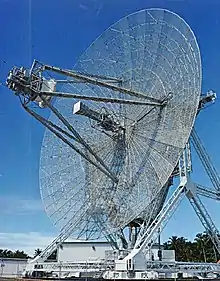ALTAIR (Radar)
ALTAIR (ARPA Long-Range Tracking And Instrumentation Radar) is a radar tracking station on Roi-Namur island in the north part of the Kwajalein atoll in the Marshall Islands. It is a high-sensitivity, wide-bandwidth, coherent, instrumentation and tracking radar that is capable of collecting precise measurements on small targets at long-ranges. ALTAIR supports several operating modes, including tracking and signature collection at VHF and UHF. It is part of a network of contributing radar sensors that perform deep-space tracking.[2]
 Cassegrain antenna of ALTAIR | |
| Country of origin | US |
|---|---|
| Designer | MIT Lincoln Laboratory |
| Introduced | 1969 |
| Frequency | 162 and 422 mc |
| PRF | 300 pps |
| Beamwidth | 1.1° (UHF) 2.8° (VHF) |
| Pulsewidth | 80 µsec |
| Range | 42,000 km |
| Diameter | 45.7 m (150 ft) |
| Precision | 20 m (66 ft) |
| Power | 5 MW |
The antenna uses a steerable 150-ft dish (46-m-diameter) and employs a focal point VHF feed and multimode Cassegrain UHF feed in conjunction with a frequency selective sub-reflector (5.5 m diameter).[3]
The radar became operational in 1969.[4] The original task was to detect and track intercontinental ballistic missiles. It is currently used to measure satellite orbits and meteor echoes in low-Earth orbit,[5] and to observe ionospheric irregularities and background densities.[6]
References
- J. A. Nelson and K. R. Roth, History of Lincoln Laboratory at the Reagan Test Site, Lincoln Laboratory Journal Number 2 2012 (online PDF)
- Card Index of Radar Sets in Radartutorial
- S. Close, S. M. Hunt, F. M. McKeen and M. J. Minardi: “Characterization of Leonid meteor head echo data collected using the VHF-UHF Advanced Research Projects Agency Long-Range Tracking and Instrumentation Radar (ALTAIR)”, MIT Lincoln Laboratory, Lexington, Massachusetts, USA, in RADIO SCIENCE, VOL. 37, NO. 1, 1009, 10.1029/2000RS002602, 2002 (online PDF)
- Sidney G. Reed, Richard H. Van Atta und Seymour J. Deitchman DARPA technical accomplishments : an historical review of selected DARPA projects, Institute for Defense Analyses, Alexandria, Va. und [1990-1991]
- Sigrid Close et al.: “Simultaneous dual-frequency observations of meteor head echoes using ALTAIR”, In: Proceedings of the Third European Conference on Space Debris, 19–21 March 2001, Darmstadt, Germany. Ed.: Huguette Sawaya-Lacoste. ESA SP-473, Vol. 1, Noordwijk, Netherlands: ESA Publications Division, ISBN 92-9092-733-X, 2001, p. 237 - 242 (online PDF)
- D.M.Towle: “ ”, Lincoln Laboratory, Massachusetts Institute of Technology, Lexington, Massachusetts 02173, in Radio Science 1980, p. 71 ()
![]() This article incorporates text available under the CC BY-SA 3.0 license.
This article incorporates text available under the CC BY-SA 3.0 license.